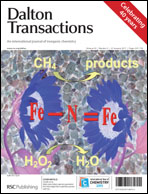An uncommon coordination protocol induced by the p-tolylsulfonyl dithiocarbimate ligand (L) [L = p-CH3C6H4SO2N![[double bond, length as m-dash]](https://www.rsc.org/images/entities/char_e001.gif) CS22−] in conjunction with PPh3 allowed the formation of novel homodimetallic, Cu2(PPh3)4L (1), trinuclear heterometallic Cu2Ni(L)2(PPh3)4 (2) and heteroleptic complexes of general formula cis-[M(PPh3)2L] [M = Pd(II) (3), Pt(II) (4)]. The complexes have been characterized by microanalysis, mass spectrometry, IR, 1H, 13C and 31P NMR and electronic absorption spectra and single-crystal X-ray crystallography. 2 uniquely consists of square planar, trigonal planar and tetrahedral coordination spheres within the same molecule. In both heteroleptic complexes 3 and 4 the orientation of aromatic protons of PPh3 ligand towards the Pd(II) and Pt(II) center reveals C–H⋯Pd and C–H⋯Pt rare intramolecular anagostic or preagostic interactions. These complexes exhibit photoluminescent properties in solution at room temperature arising mainly from intraligand charge transfer (ILCT) transitions. The assignment of electronic absorption bands has been corroborated by time dependent density functional theory (TD-DFT) calculations. Complexes 1 and 2 with σrt values ∼ 10−6 S cm−1 show semi-conductor properties in the temperature range 313–403 K whereas 3 and 4 exhibit insulating behaviour.
CS22−] in conjunction with PPh3 allowed the formation of novel homodimetallic, Cu2(PPh3)4L (1), trinuclear heterometallic Cu2Ni(L)2(PPh3)4 (2) and heteroleptic complexes of general formula cis-[M(PPh3)2L] [M = Pd(II) (3), Pt(II) (4)]. The complexes have been characterized by microanalysis, mass spectrometry, IR, 1H, 13C and 31P NMR and electronic absorption spectra and single-crystal X-ray crystallography. 2 uniquely consists of square planar, trigonal planar and tetrahedral coordination spheres within the same molecule. In both heteroleptic complexes 3 and 4 the orientation of aromatic protons of PPh3 ligand towards the Pd(II) and Pt(II) center reveals C–H⋯Pd and C–H⋯Pt rare intramolecular anagostic or preagostic interactions. These complexes exhibit photoluminescent properties in solution at room temperature arising mainly from intraligand charge transfer (ILCT) transitions. The assignment of electronic absorption bands has been corroborated by time dependent density functional theory (TD-DFT) calculations. Complexes 1 and 2 with σrt values ∼ 10−6 S cm−1 show semi-conductor properties in the temperature range 313–403 K whereas 3 and 4 exhibit insulating behaviour.

You have access to this article
 Please wait while we load your content...
Something went wrong. Try again?
Please wait while we load your content...
Something went wrong. Try again?
![[double bond, length as m-dash]](https://www.rsc.org/images/entities/char_e001.gif) CS22−] in conjunction with PPh3 allowed the formation of novel homodimetallic, Cu2(PPh3)4L (1), trinuclear heterometallic Cu2Ni(L)2(PPh3)4 (2) and heteroleptic complexes of general formula cis-[M(PPh3)2L] [M = Pd(II) (3), Pt(II) (4)]. The complexes have been characterized by microanalysis,
CS22−] in conjunction with PPh3 allowed the formation of novel homodimetallic, Cu2(PPh3)4L (1), trinuclear heterometallic Cu2Ni(L)2(PPh3)4 (2) and heteroleptic complexes of general formula cis-[M(PPh3)2L] [M = Pd(II) (3), Pt(II) (4)]. The complexes have been characterized by microanalysis, 

 Please wait while we load your content...
Please wait while we load your content...